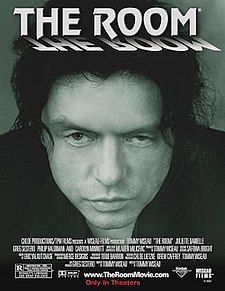Ground Your Reader, or Why Storyboarding is Important
 The Room is our generation’s Rocky Horror*. It’s at best a D-List movie with horrible stock footage and acting right out of a CCD production of Best Christmas Pageant Ever. The writing is Nemesis-worthy.
The Room is our generation’s Rocky Horror*. It’s at best a D-List movie with horrible stock footage and acting right out of a CCD production of Best Christmas Pageant Ever. The writing is Nemesis-worthy.
He would’ve definitely benefited from using a storyboard, which is something I thought all film types did in form or another. For the sake of this post, storyboarding will encompass actual storyboards, maps, and logical sense.
Example a la The Room: Lisa and Johnny are to be married in a month. Lisa is throwing a surprise birthday for Johnny in less than a week. The infamous tuxedo scene happens before the surprise party**.
Further Example a la The Room: At the start of the movie, there is a mention that Johnny and Lisa have been together for five years. At the end, someone else mentions it’s been seven years. There’s no indication that the movie takes place over a two-year span.
Why Storyboard? If you lay everything out, you’ll see where your inconsistencies lie, therefore making your story tighter. (Holly does this with her snazzy outline breaking it out by timestamp.)
2. Pacing. Does your action scene actually go fast? Did you include that much needed beat in between sentences?
Example a la The Room: I’ll just let Tommy help out here.
Why Storyboard? While storyboarding won’t help with that dialogue beat, it can help you figure out the logistics of your fight scene.
3. Logistical Plausibility. If you deal with multiple settings, it can be difficult to remember that the door is on your protagonist’s left or that this room has no windows.
Example a la The Room: For most of the scenes in Johnny and Lisa’s apartment, we see the living room from one angle. This angle gives us their couch which is in front of a window and has a coffee table in front. The outside door is house left of the couch. There’s only one scene where we see the other part of the apartment, which confuses the viewer to the point where we think the scene with the fireplace is a different location.
Further Example a la The Room: Right before the surprise party, we watch Johnny walk home from presumably work***. The walk takes over an hour****. Now yours truly walks 45 minutes each way to work, but she doesn’t do it in dress shoes and a business suit.
Why Storyboard? Figuring out simple things like the commute home (if that’s important to your novel) aids in the believability of your characters’ world.
That’s what I learned from watching The Room. If you want more writing tips from this heckle-tastic movie, hop on over to Kat’s, Erinn’s, or Pam and Quita’s blogs where they’re sharing their learning experiences as well. Also, one of us will be giving away this awesomeness this week. Stay tuned.
And if you learned something from The Room, do tell.
**** No, I didn’t locate all this information. Someone had done the work for me.
________________
Last.fm hit of the day: The Reckoning by Godhead
Strangely, you're making me want to see the movie even more. I mean, it has to be so bad it's good. I love your example about sense of time. Ha ha. This reminds me of plays we made as kids, when we'd change the facts as we went along.
I learned that sometimes you just don't get that promotion, even though you saved them 'bondles'. And, apparently, that vodka mixed with whisky makes an acceptable drink. Devotees of the room call it 'Scotchka'.
I'm kind of weirdly excited to see this movie now.
ha ha mention of nemesis!!
Great examples- love it!
This is very informative! Good job, Alicia…and I seriously want to ask Tommy Wiseau: What's up with the 5 year, 7 year thing? That part bothers me the most for some reason.
This was so in depth. Now I want to watch it again just to see how inconsistent the settings are. Okay, who am I kidding? I also want to laugh my ass off, too. 🙂
I want to see this movie. I'll look it up on Netflix.
Even though I've seen it a bunch of times in the theatre, I don't think I've learned anything… however, for those who wish to read my take on the film and about meeting Tommy Wiseau, you can read here–
http://angelichorrors.blogspot.com/2010/02/i-entered-room-and-left-forever-changed.html
Also, actor Greg Sestero (Mark) is in the process of writing a "tell-all" book about his experience and the real story behind Tommy. I'm excited for it to come out!